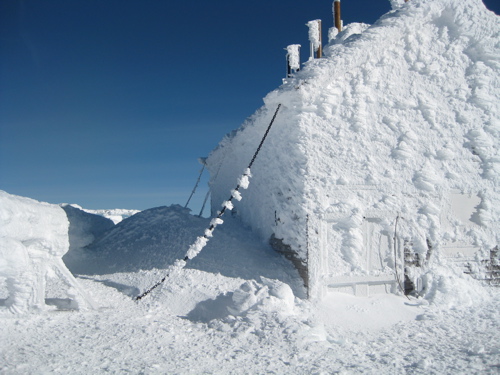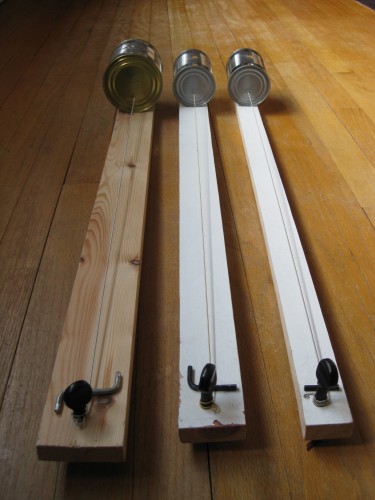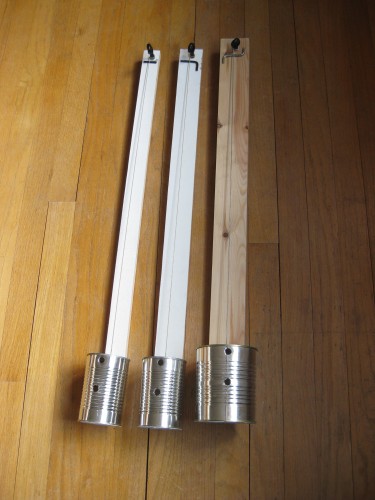Here are the sounds of a suspension bridge I recorded on a recent trip to Camp McDowell in Nauvoo AL. I used two contact mics, one on each set of main cables. The bridge was surprisingly quiet during normal use and even when I bounced and jostled it a bit, so I tapped and scraped on the structure with a few sticks. Sounds best on headphones!
Tag Archives: contact mic
Music for Folding Chair
I made these 4 short pieces to celebrate the new folding chairs ASAC has provided for the UAG. One folding chair, two contact mics, a superball mallet, a cheap cello bow and Max–the pieces practically made themselves.
Today’s Fun: Diddley Bows
Inspired by Mike Orr’s Handmade Music Factory book I grabbed some scrap wood and empty soup cans and hacked together three diddley bows. They sound a bit like a berimbau crossed with a one-string Resophonic guitar. I’ll post some sounds once I find my way around the instruments. I’ll likely add guitar pickups or contact mics, too.
Mt. Washington Pt. 2: Rime
January 11: Summit Weather
- High temp: 5 F
- Low temp: -2 F
- Average Wind Speed: 46.7 mph gusting to 72 mph
A foggy day with visibility down to 1/16th of a mile. The observatory reported zero hours of sunshine for the day. Perfect conditions for rime ice. We could hardly step outside without it accumulating on our clothes and, of course, our gear.

My recording bag covered in rime ice. My headphones were unscathed since I wore them under my balaclava (and hat (and parka hood)).

I brought out my contact mics to record the sound of rime accumulating on them. The best spot I found was attaching them to the windward side of a wooden sign post. Here’s an excerpt:
[audio:rime_accumulation.mp3]Listening to the entire recording one can clearly hear the frequency of the resonant ping sounds increase as more ice accumulates. I suspect the ice accumulation reduces the surface area of the contact mic or otherwise stiffens the transducer–in a manner similar to a drummer increasing the pressure on a drum head and thus causing the pitch to rise.
Here’s a recording of an ice-covered chain squeaking in the wind. The squeak is less metallic than I expected, sounding more like rubbing ice cubes together.
[audio:squeaky_chain.mp3]
Here’s a photo of the chain (taken on another, much sunnier day). Yes, this chain appears to be preventing the building from blowing off the mountain. The story I heard is that the chains were an important part of the original building. When they rebuilt the structure, chains were included as an historical and decorative element. There were times when I could have used a chain or two to prevent me from blowing away.

Jackie and I covered in rime ice after our contact mic recording expedition.
One Month to the Mountain

Late Afternoon Cogs Heads Down, Photo by Jeff Glover
I’m headed to the top of Mt. Washington in about a month. I’ll be recording audio for an experimental documentary project led by Jacqueline Goss. At Jackie’s request I’ve been reading material on the history and operation of the Mt. Washington Observatory. I’m already having fun geeking out about cloud cover and wind speed and fog and rime.

Jacqueline Goss, from The 100th Undone
Still trying to figure out how to actually record usable sound in 50mph wind… I’m currently building a handful of DIY contact mics/hydrophones in anticipation of recording ice accumulation and the straining of various summit structures in full-on gales. I’m also building a few electret omni mics so I can have something to take outside with impunity in the worst conditions. I’ll try to post some photos of my homebrew audio projects. Also look for future reports and audio samples from the mountain top.
Making Tracks for the TrackBox
 I saw this “cyber” Monday special from audioMIDI.com: Nomad Factory’s Blue Tubes Trackbox for $15 (expires Sunday 12/6). I downloaded it to see if it might replace the TubeMP 12AX7 tube preamp I use between my banjos and audio interface. I use the preamp to soften the tone of the admittedly harsh piezo contact mics I use on my banjos. Driving the tube a little harder provides some welcome compression and the limiter helps tame the spiky sounds from a piezo on a frailed banjo.
I saw this “cyber” Monday special from audioMIDI.com: Nomad Factory’s Blue Tubes Trackbox for $15 (expires Sunday 12/6). I downloaded it to see if it might replace the TubeMP 12AX7 tube preamp I use between my banjos and audio interface. I use the preamp to soften the tone of the admittedly harsh piezo contact mics I use on my banjos. Driving the tube a little harder provides some welcome compression and the limiter helps tame the spiky sounds from a piezo on a frailed banjo.
In my initial tests, I’ve been pleasantly surprised with how well the TrackBox nails the tube sound–a little goes a long way. And the 4-band parametric equalizer seems eminently usable. Testing it as a VST in Max 5 it used about 7% of my CPU (an aging PowerPC G4) with all the bells and whistles turned on and was closer to 4% with only the tube and EQ running.
I’m not convinced I’ll leave my tube hardware at home just yet–without a hardware limiter in front of my audio interface I have to drop the input level significantly to avoid clipping. By the time I’ve pulled the level back up I’ve also introduced some noise. The tone-shaping potential of the EQ and compressor might be worth it, especially if I need to travel light. In the meantime, it’s nice to have another channel strip color.


